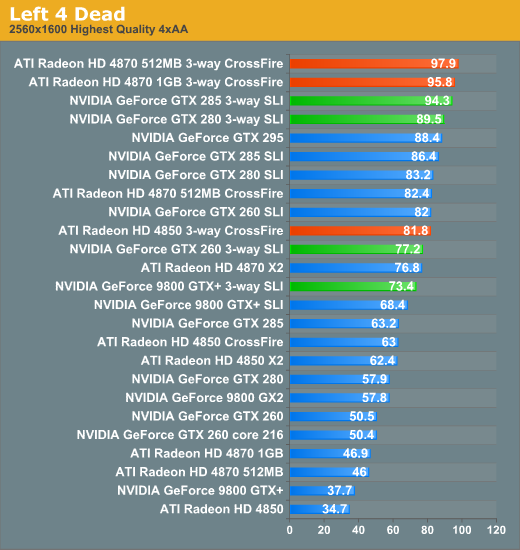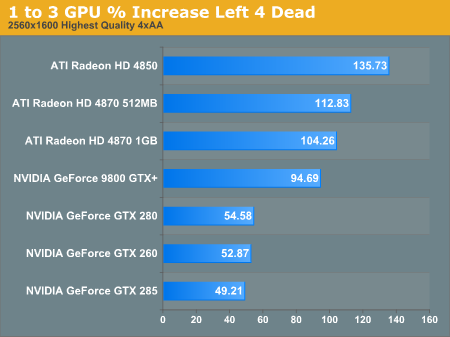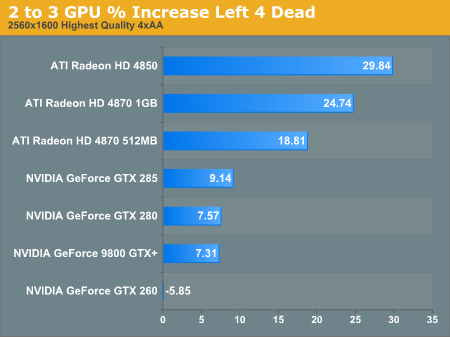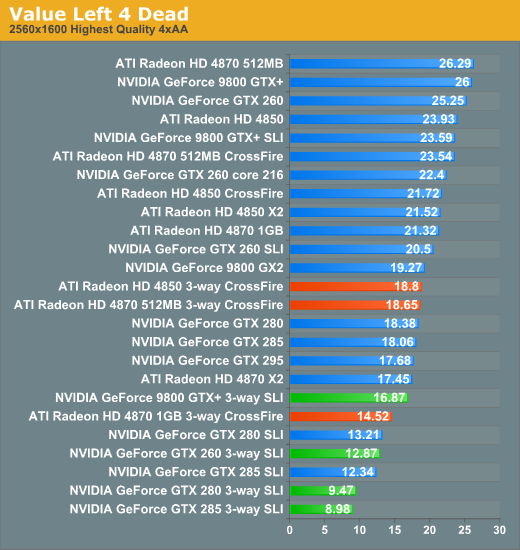MultiGPU Update: Does 3-way Make Sense?
by Derek Wilson on February 25, 2009 2:45 PM EST- Posted in
- GPUs
Left 4 Dead Analysis
This game runs really well on all our hardware, so 3-way isn't necessary, but the Source engine also scales well with multiple GPUs despite it's already high performance.

1680x1050 1920x1200 2560x1600
In this case, AMD hardware out performs the rest of the lineup. Both the 512MB and 1GB versions of the 4870 outperform the highest end NVIDIA hardware. This also shows that Left 4 Dead doesn't trash graphics memory and does a good job making things look pretty without requiring cards to have more RAM onboard.

1680x1050 1920x1200 2560x1600
The Radeon HD 4850 always scales pretty well, while other cards hit a bit of a system limitation at lower resolutions. Moving up to 2560x1600, the AMD cards all show that they can scale better than NVIDIA hardware in this game.

1680x1050 1920x1200 2560x1600
At 1680x1050, only the GTX 280 and 285 really scale up from 2 GPUs to 3. 2560x1600 shows another side of the coin where all the ATI hardware scales pretty well while NVIDIA hardware can't push past a 10% improvement from 2 to 3 GPUs. Two do pretty well on their own, but AMD comes through better on this one.

1680x1050 1920x1200 2560x1600
Despite the high performance and good scaling, our value data still shows the 3-way solutions on the lower end of the spectrum. AMD's cards do tend to lead in value among the 3-way options and even best the single GTX 280 and 285 at 2560x1600.










46 Comments
View All Comments
Snarks - Wednesday, February 25, 2009 - link
hmm, i find my self questioning these articles more and more..but anyway carry on.
DerekWilson - Wednesday, February 25, 2009 - link
what's the question ... seriously, any criticism is helpful. this is the first time we've really done a series like this, and it's a complicated situation with lots of data and lots of analysis ... there's no one way to look at it, and all the feedback i get will help me down the road.i don't see the need for this type of article or series very frequently, but we'll have to do it every once in a while just in case something changes. knowing what you guys think is important and what you guys want to read about is key to us getting things done right.
Flyboy27 - Wednesday, February 25, 2009 - link
Sell you an extra card that you don't really need.Flyboy27 - Wednesday, February 25, 2009 - link
oh yeah... and a more expensive motherboard, power supply, and case.Burrich - Wednesday, February 25, 2009 - link
Would the recently release Catalyst 9.2 drivers improve any compatibility or fps issues? Their release date was 2/20.7Enigma - Thursday, February 26, 2009 - link
Check out xbitlabs' review of the 9.2 drivers. If you have a 4870 X2 then yes it appears to be a nice upgrade for several games with minimal losses in the games it doesn't benefit. But if you are sporting a single 4870 1gig it actually degrades performance more than it improves!On the flipside they claim stability is better with the 9.2's so it depends on what you want/need. If you are comfortable with the framerates in the games you currently play then jump on the 9.2's for stability reasons. If you are on the edge of playable performance I would stick with the previous drivers...
http://www.xbitlabs.com/articles/video/display/cat...">http://www.xbitlabs.com/articles/video/display/cat...
DerekWilson - Thursday, February 26, 2009 - link
That article compares 9.2 to 9.1 ... the 8.12 hotfix would show similar performance improvements over the 9.1 drivers. 9.2 does benefit more games, but these are games that have been more recently released than the ones we tested.if they compared the 8.12 hotfix to 9.2, we would expect to see more parity, especially with the games we tested in this article.
DerekWilson - Wednesday, February 25, 2009 - link
The recently released 9.2 catalyst drivers are basically the 8.12 hotfix drivers with some additions to support performance and scaling in recently released titles. So not really.smartalco - Wednesday, February 25, 2009 - link
I don't like that you use 0 for those that score under 25 FPS, specifically because that is under 25 at the res/settings you use. If a card scores 24 FPS at 1680*1050 with maxed settings, what that really tells you is that if you were to drop to half the AA, or turn down some other setting, is that you could still have a perfectly playable game. It seems to me, that giving them a value rating of 0 is acting like everyone has to play on max settings, and if it doesn't meet the standard, its useless.IDK, just me talking, I'm going to be happy with my 4850 for quite some time.
Still an excellent article.
DerekWilson - Wednesday, February 25, 2009 - link
i've actually got the graphs without the 0 scores in the article front to back -- just commented out at the moment ... i wasn't sure which one to go with until the last minute, and i thought about putting both in (but that wouldbe really redundant for games that no card had trouble with)i could do some more complex web programming, but i'm not a web developer and i hate javascript ...
thanks for the feedback. i'll be taking it into account in the final article on 4-way.
also, if you wanna see the value numbers for the single and dual cards that scored less than 25 fps, you can still look at the first article and see them.